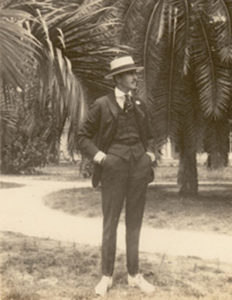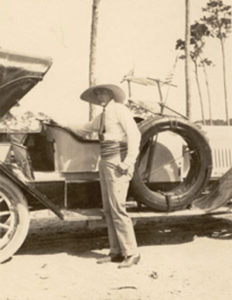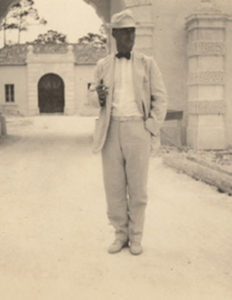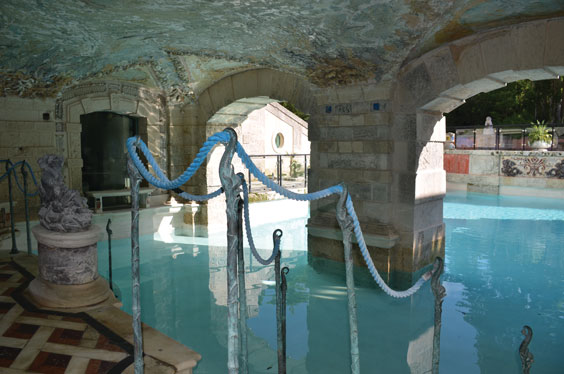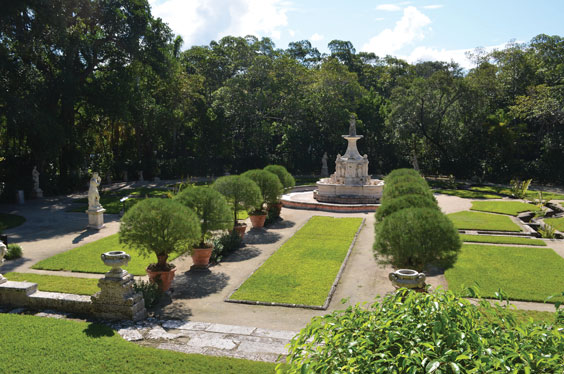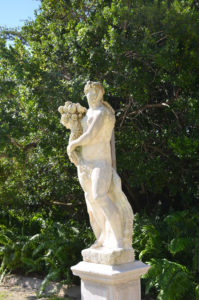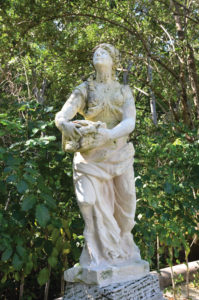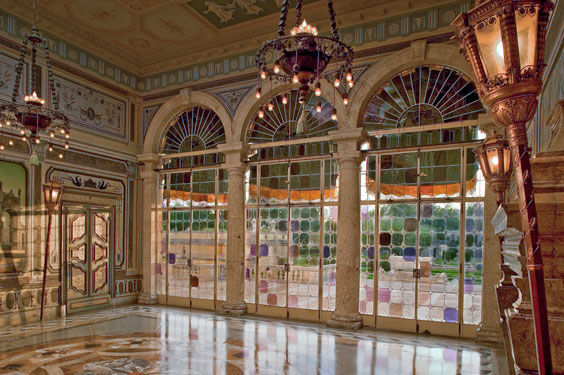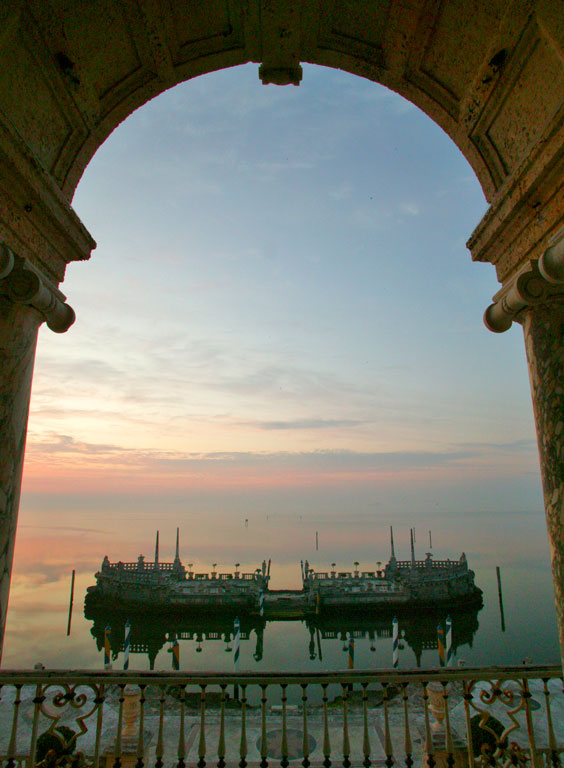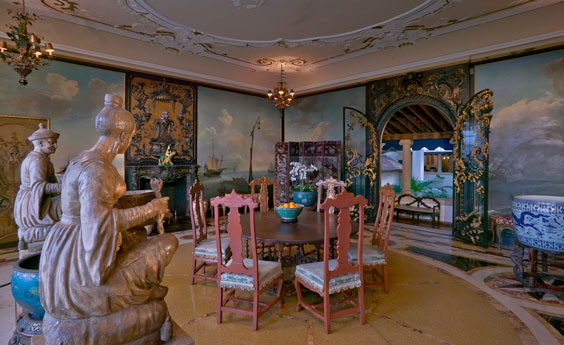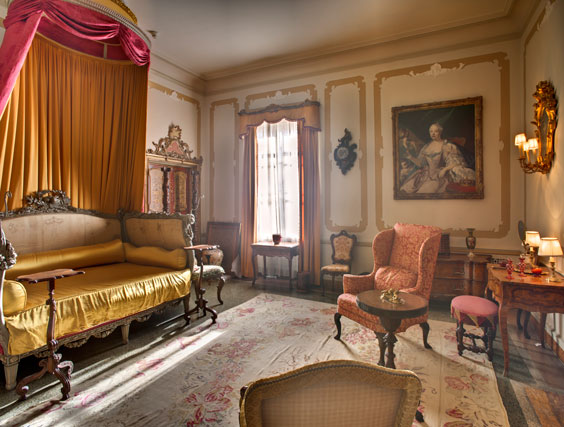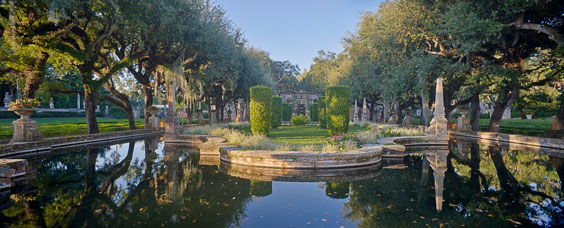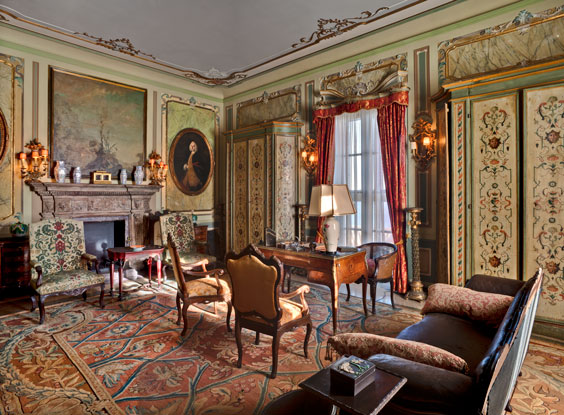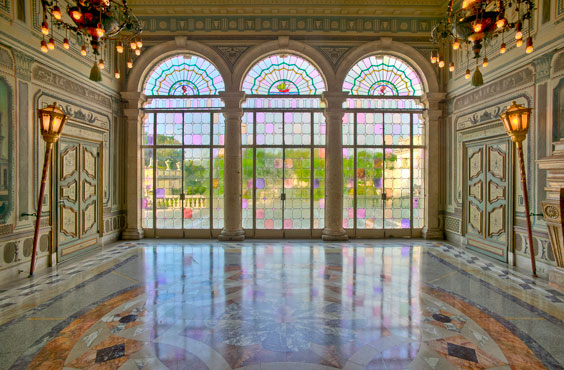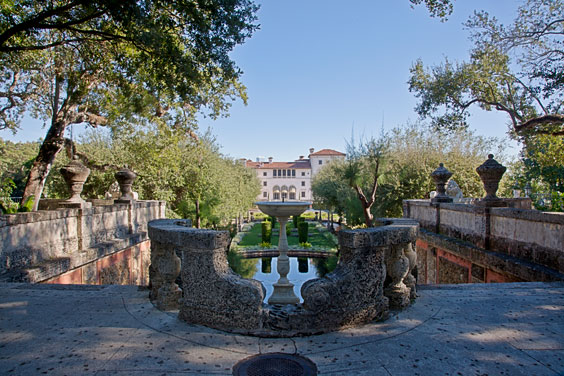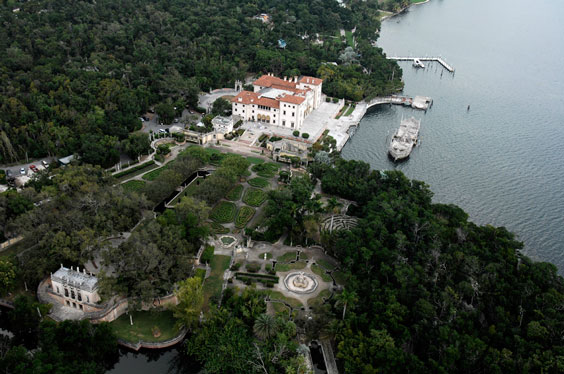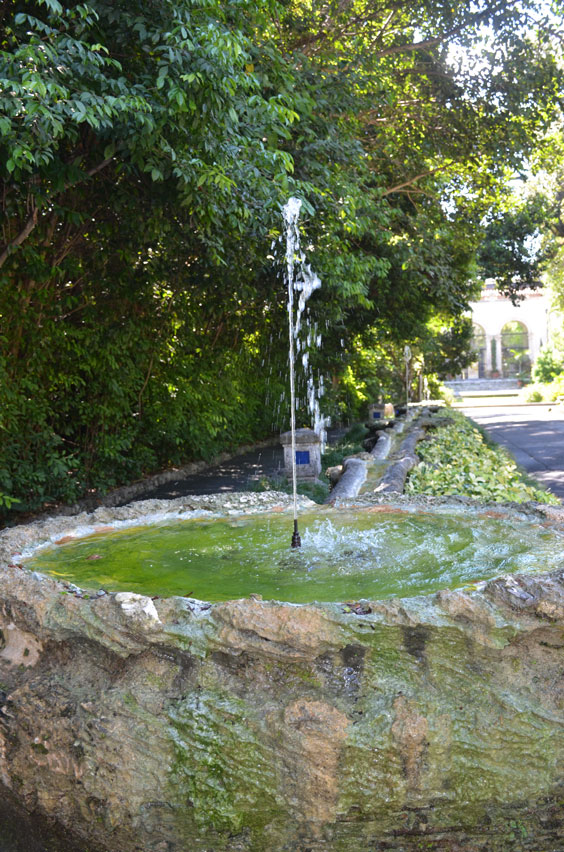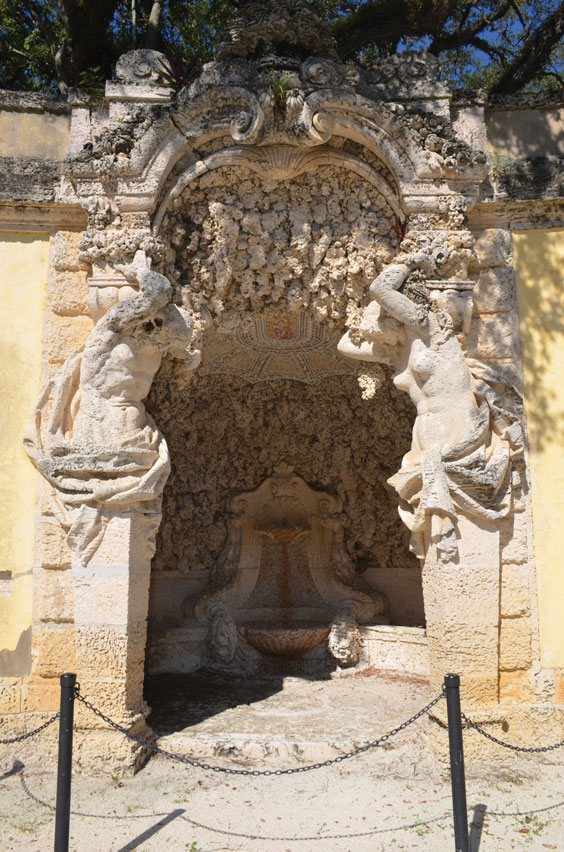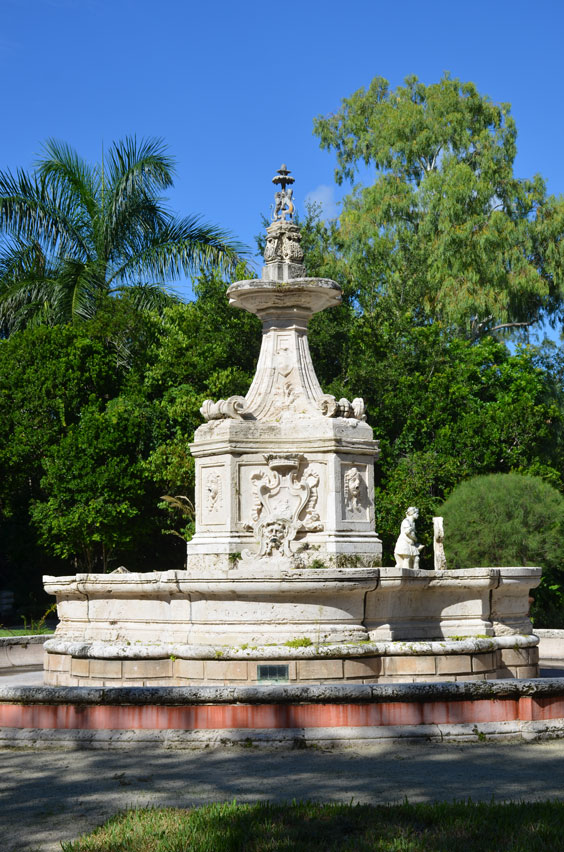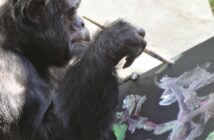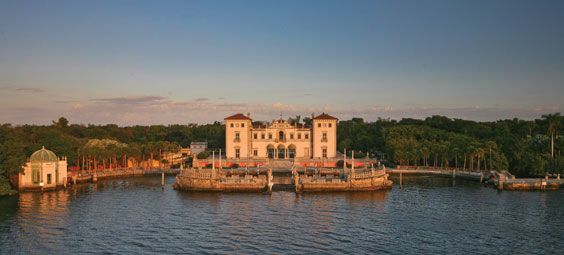
Vizcaya, James Deering’s sumptuous home filled with fine art and antiques, and gardens festooned with sculpture, fountains, and grottoes, celebrates its 100th anniversary this year. Through time, the millionaire’s winter residence has moved from private home to that of a highly-regarded, accredited museum, National Historic Landmark, and popular attraction. Deering’s purchase of 180 acres in Coconut Grove was on densely forested land bordered by mangrove swamp and Biscayne Bay. Into this untamed land was imposed a grand palace with a design aesthetic borrowed from an Italian villa and formal gardens inspired by the Renaissance. The success of designer and decorator Paul Chalfin, architect Francis Burrall Hoffman, Jr., and landscape designer Diego Suarez was to create a place that was highly evocative of Europe while being sensitive to the site’s subtropical environment.
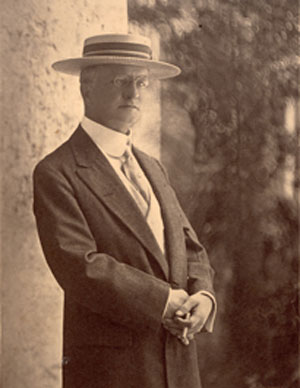
Photo credit: Vizcaya Museum & Gardens Archives
James Deering
James Deering (1859-1925) was born in South Paris, Maine, the son of William Deering and his second wife, Clara Hammond Deering. His father inherited a woolen mill but later turned his eyes westward and moved his family to Chicago where he purchased a farm equipment manufacturing firm. He renamed it the Deering Harvester Company. In 1880 James and his half-brother Charles Deering (1852-1927) joined the company.
Deering Harvester went on to great success, eventually merging with other companies to become International Harvester in 1902. The new company quickly became one of the leading manufacturers of farming implements, remaining so for most of the 20th century and making the Deering family one of the wealthiest in America.
James worked for the company until 1908. He served as vice president until 1919 and was a director of the company until his death in 1925. Deering never married and had no children.
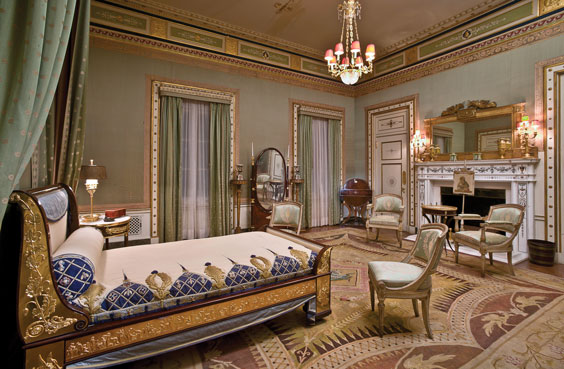
James Deering’s Bedroom. Photo by Bill Sumner, courtesy of Vizcaya Museum & Gardens
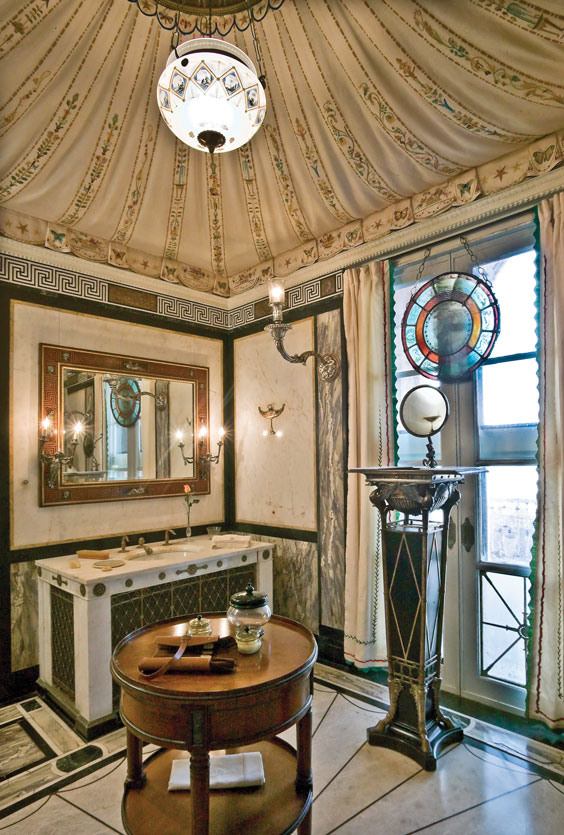
James Deering’s Bathroom. Photos by Bill Sumner, courtesy of Vizcaya Museum & Gardens
Members of the Deering family were not strangers to Florida; they had previously spent time in Saint Augustine to improve William Deering’s failing health. Later William would purchase land in Coconut Grove. James, who suffered from pernicious anemia, was also advised by his physician to winter in south Florida for the warmth and sunshine.
In 1912, he purchased 130 acres of land in the Grove; two years later he bought another 50 acres. He began his project to build his Florida home—something in which he would be fully engaged until the end of his life at the age of 66 aboard the SS CITY OF PARIS as it was returning from Europe to the United States. He left Vizcaya to his brother Charles.
Villa Vizcaya
Vizcaya was likely inspired by the baroque Villa Rezzonico-Borella in Bassano del Grappa, in the Italian Veneto, built in the 17th and 18th centuries. Deering was very involved in the design and decoration of his future palace on the bay. An avid sailor, he wanted the house to be seen and approached from Biscayne Bay. The east façade with its wide terrace and the decorative “barge” seemingly afloat in the water have never lost their ability to impress. The west side of the home was the proper front entrance for visitors coming by land. The north side includes a swimming pool under arches and on the south, the entrance to the elaborate gardens with loggias on the first and second floors.
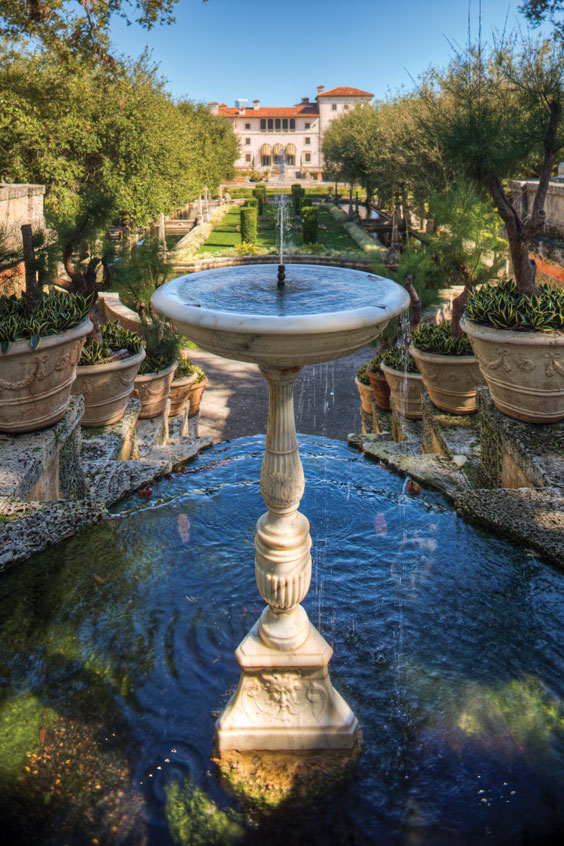
Exterior photos on these pages, courtesy of Vizcaya Museum & Gardens. (Except as noted)
The main house is distinguished in the United States for its Renaissance-inspired architecture and interiors replete with European antiques and American art commissioned in the 19th century. Inside on the first floor, there are reception rooms, the library, music room, and dining room surrounding the large courtyard. The courtyard, now covered with a glass roof, was designed to be open to the elements. The second floor includes Deering’s suite of rooms, guest bedrooms, a breakfast room, and the kitchen.
Although the house is deferential to European decorative traditions, Vizcaya was designed to include the latest in technology, with heating and ventilation, elevators, central vacuum-cleaning system, a dumb-waiter, and an updated laundry room.
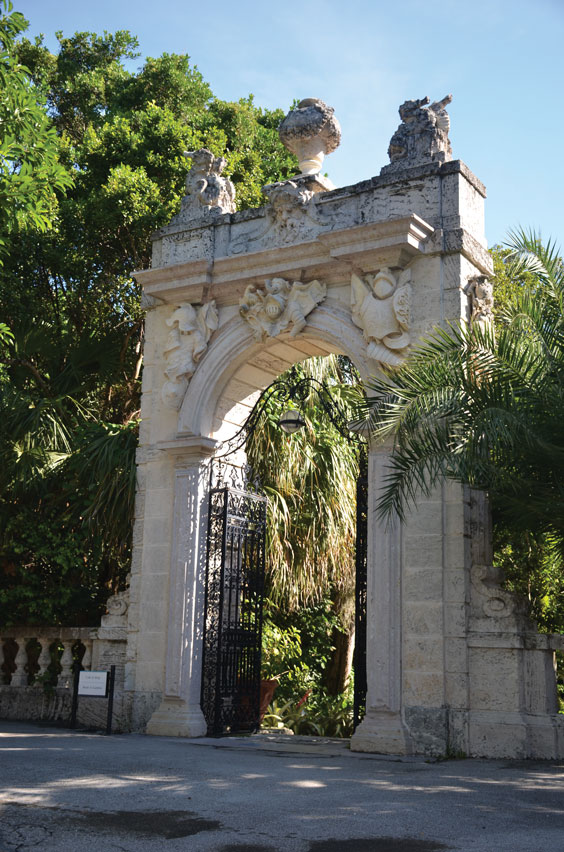 In an interest to make Vizcaya virtually self-sufficient, Deering had the Village built apart from the house and formal gardens. It contained staff housing, maintenance buildings, garages, stables, a dairy, a poultry house, and greenhouses. The estate also had a working farm and citrus grove. Today the Village consists of nearly a dozen buildings, from the east and west gate lodges on either side of South Miami Avenue to the poultry barn along US Route 1.
In an interest to make Vizcaya virtually self-sufficient, Deering had the Village built apart from the house and formal gardens. It contained staff housing, maintenance buildings, garages, stables, a dairy, a poultry house, and greenhouses. The estate also had a working farm and citrus grove. Today the Village consists of nearly a dozen buildings, from the east and west gate lodges on either side of South Miami Avenue to the poultry barn along US Route 1.
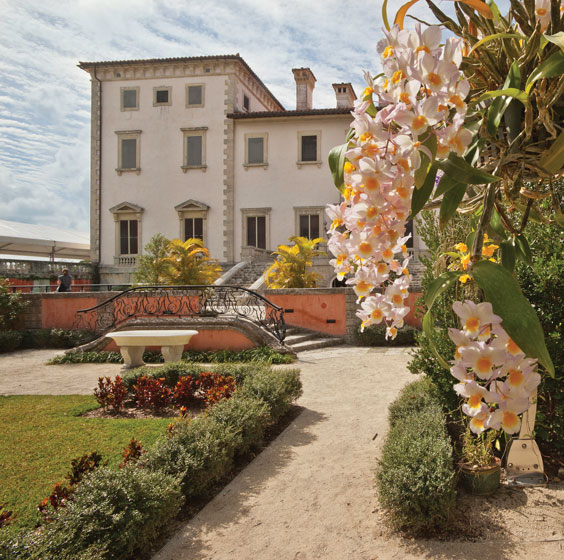 Conceiving, designing and building Vizcaya was a massive project that employed approximately 1,000 workers, a full 10 percent of Miami’s population at the time.
Conceiving, designing and building Vizcaya was a massive project that employed approximately 1,000 workers, a full 10 percent of Miami’s population at the time.
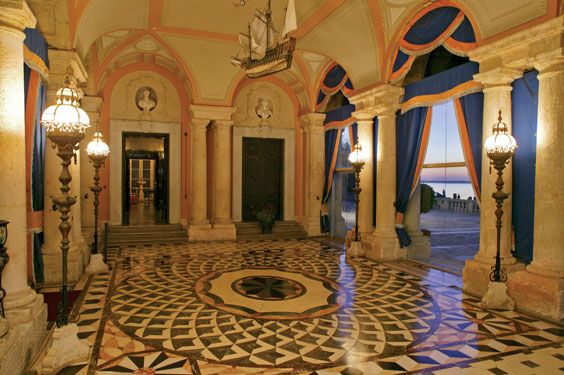
East Loggia – Photo by Bill Sumner
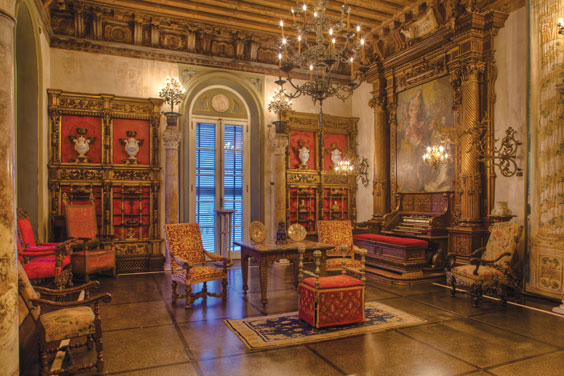
Living Room – Photo by Bill Sumner
By Design: Chalfin, Hoffman, and Suarez
James Deering worked together with a team of three men, Chalfin, Hoffman, and Suarez to make Vizcaya a reality. New Yorker, Paul Chalfin (1874-1959), was an artist who studied in Europe at the École des Beaux-Arts in Paris and later served as the curator of Asiatic arts of the Museum of Fine Arts Boston. Chalfin returned to Europe in 1906 for a painting fellowship at the American Academy in Rome. He studied and traveled extensively through Italy for the next three years. He fully embraced the Italian design aesthetic, became fluent in Italian, and building networks with people in the Italian art market. Although not a trained architect, Chalfin had a great love of and sensitivity to the discipline. His relationship with Deering was one of trust and collaboration, and his keen sense of design and understanding of the role of the decorative in architecture served in the successful creation of Vizcaya. Chalfin was responsible for the choice of the general overall design of the main house and garden, and for decorating and furnishing the interior of the main house.
Accordingly to Vizcaya’s website: The interiors of the Main House were meant to suggest the passing of time and the layered accumulation of artifacts and memories. The rooms were designed around objects acquired in Italy and assembled into new compositions by Chalfin.
Francis Burrall Hoffman, Jr. (1882-1980) was a professional architect who implemented Chalfin’s design aesthetic into Vizcaya’s architecture. He studied at Harvard and the École des Beaux-Arts in Paris and worked in the architect office of Carrère and Hastings, establishing his own office in 1909 in New York. True to his Beaux-Arts training, Hoffman designed an essentially square building allowing for movement along a main east-west axis from the entrance through the courtyard to the terrace facing Biscayne Bay. Hoffman worked on Vizcaya until 1917, when he joined the army to serve in France during World War I. He enjoyed a lengthy architectural career, but Vizcaya remained his most notable project.
Colombian-born, Diego Suarez (1888-1974), a landscape architect, lived in his mother’s native Italy after the death of his father, a diplomat. He studied architecture at the Accademia di Belle Arti in Florence and designed many formal gardens for private homeowners. It was in Florence that he met Deering and Chalfin. Suarez was invited to the United States by an American patron and became stranded in New York when the war broke out. At Vizcaya, Suarez took into account the flatness of the topography, the many hours of Florida sunshine, and the semi-tropical climate. He fashioned a European garden aesthetic with local stone and native plantings. Using low hedges, he created strong perspective lines in the French parterres style of formal gardens. He made slight changes to the levels of certain areas to give interest to the flat topography. In addition to complementing the main architecture and other structures such as the Casino on the mound.
Suarez created a garden of discoveries, rewarding a visitor’s walk with a grotto, a fountain, or a statue.
Like Hoffman, Suarez also left the project in 1917. The villa was completed for residency in 1916, and the formal gardens and acres of landscaped grounds completed in 1922.
- Francis Burrall Hoffman
- Paul Chalfin
- Diego Suarez
Vizcaya Through Time
James’ brother Charles Deering inherited the estate upon James’ death in 1925. The highly destructive hurricanes of 1926 and 1935 left their mark on Vizcaya, destroying garden statuary and furnishings as well as a major portion of tree canopy.
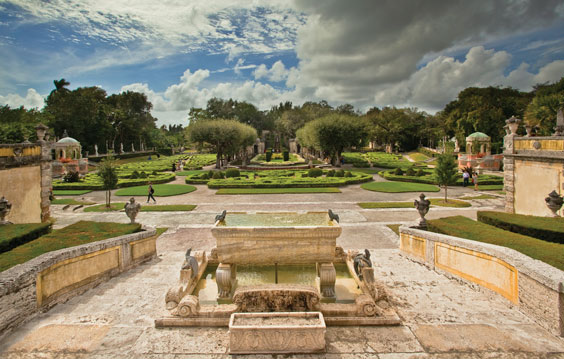
Garden overview from North
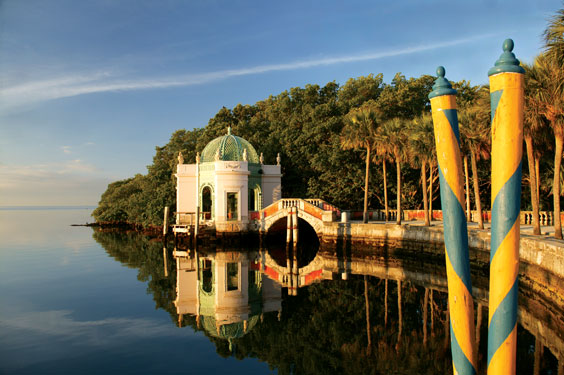
Tea House
In 1945, the archdiocese of Miami purchased 130 acres of the estate, filled in Deering’s lagoon and built a hospital, school, and housing. Dade County purchased Vizcaya, the gardens, the remaining village, and adjacent grounds in 1951. Deering heirs loaned the County the funds to make the alterations and repairs necessary to open the site as a museum. The heirs also donated thousands of objects to the County for repatriation to the site over a period of years.
The museum opened in 1953.
The wind and water surge brought destruction to Vizcaya once again when Hurricane Andrew blew into Biscayne Bay in 1992. One of the worst hurricanes on record flattened mangroves, stripped and brought down trees, and heavily damaged the barge, railing and terraces. However, the main house survived intact. The 2005 hurricane season brought in Katrina and Wilma that damaged interiors of the house and caused extensive harm to the barge, garden
and tree canopy.
Celebrating Vizcaya
Today, Vizcaya Museum and Gardens remains a public museum with the main house of 34 decorated rooms, 10 acres of formal gardens, collections that include European antiquities, American art commissioned in the 1900s, and mature plantings. The village buildings continue to be restored for future programming and other projects are being completed that serve to enhance both the visitor experience and a greater understanding of the site at its peak of completion in 1922.
- Grotto Pool restoration (2016)
- Fountain Garden with the center “Sutri Fountain,” named after the town from which it originated. Recent restorations were completed with a grant from Tiffany & Co.
In this 100th year of celebrating the estate, there will be a fundraising gala in November (see inset). In addition, Lost Spaces and Stories of Vizcaya is a current exhibit that will run until October 2017 as part of the centennial observation. The inspiration for the exhibition is the loss of many of the estate’s spaces and the stories about the site that have disappeared. The two-phased exhibition will consist of installations by contemporary artists located in and around the main house and gardens that strive to bring back to life what has been lost.
Another project done in recognition of the centennial is the ongoing restoration of the swimming pool grotto and mural by Robert Winthrop Chanler (one of only two public sites in the world featuring his work). Chanler (1872-1930), an American muralist and designer, was commissioned by James Deering to paint an undersea fantasy fresco on the ceiling of his swimming pool grotto. The ceiling is both a painted and sculptural mural that Chanler completed in 1916 at the time Deering started wintering at Vizcaya. The original effect of the grotto may have drawn on grottoes in Italy, created naturally by the sea and artificially by humans. The blue pool water and the once vivid blues of Chanler’s ceiling created a surreal and magical place in which to relax.
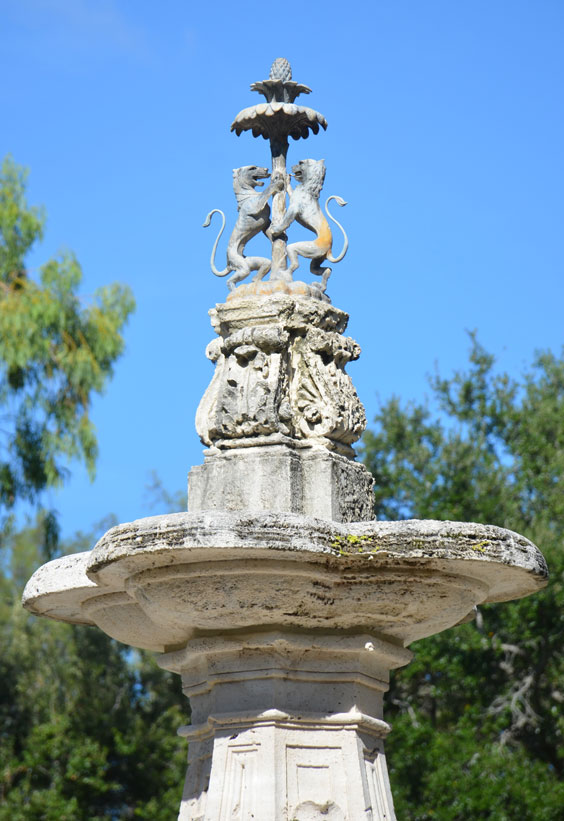 The swimming pool grotto had condition issues caused by humidity as early as 1918 (Chanler used water-soluble paint). Successive hurricane incursions have further de-stabilized the grotto. There are at least five coats of paint over Chanler’s original work. It appears that removing those layers of paint will not be possible and the goal is to stabilize the ceiling of the grotto as much as possible. The structure is safe, and the restoration focus will be on the ceiling as the curator and her team work to secure it and devise a way to protect the grotto from future hurricane damage.
The swimming pool grotto had condition issues caused by humidity as early as 1918 (Chanler used water-soluble paint). Successive hurricane incursions have further de-stabilized the grotto. There are at least five coats of paint over Chanler’s original work. It appears that removing those layers of paint will not be possible and the goal is to stabilize the ceiling of the grotto as much as possible. The structure is safe, and the restoration focus will be on the ceiling as the curator and her team work to secure it and devise a way to protect the grotto from future hurricane damage.
The experience of visiting Vizcaya takes you to a world enjoyed by the very wealthy, to a place where a stage was set to allow one man to indulge in his love of pattern, form and line. Vizcaya is this and much more. It is an educational institution touching on a variety of disciplines, a veritable petri dish for historic preservation and objects conservation challenges and successes, a decorative arts museum, a relaxing park and green space, a tourist draw, and one of those places that gives you bragging rights about how special things are where you live.
Vizcaya Museum & Gardens is located at 3251 South Miami Avenue, between Brickell Avenue and Coconut Grove. It is open daily from 9:30 a.m. to 4:30 p.m. except Tuesdays, Thanksgiving and Christmas Day. To learn more about the estate, visit Connect via social media or call 305-250-9133 to learn about ongoing events, exhibitions, and programs.
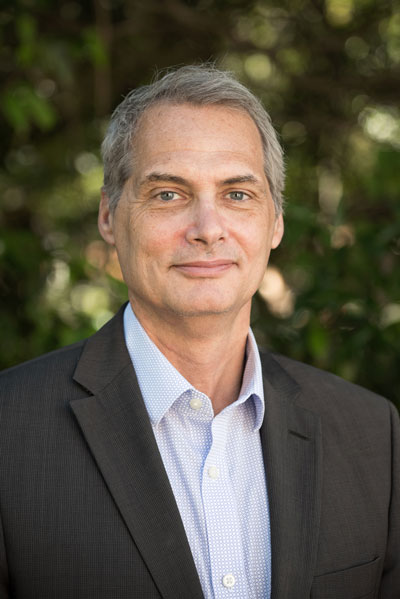
Joel Hoffman – Photo by Armando Rodriguez, courtesy of Miami-Dade County
Executive Director Joel Hoffman
Hoffman joined Vizcaya in 2004. Prior to that he oversaw the educational programming at the Brooklyn Museum and was an associate director with The Wolfsonian-Florida International University in Miami Beach. He holds a doctorate in art history from Yale University. Since 2011, Joel has served on the Board of Directors of the American Alliance of Museums.
“The centennial will focus on Vizcaya’s role as a community asset. Vizcaya is both an accredited museum and National Historic Landmark. The anniversary year will provide opportunities for students, families and visitors to engage with history, experience art and discover nature at this beautiful bayfront estate,” says Hoffman.

CENTENARY YEAR & ANNIVERSARY GALA
Vizcaya was inaugurated on Christmas Day, 1916 with an Italian-themed party.
The planned Vizcaya Centennial Gala pays homage to that event.
The Centennial Gala will be held on Saturday, November 19, 2016 from 7:00 p.m. through midnight. This fundraising event supports the preservation and protection of the estate and is the kick off of many activities over the coming year that will celebrate Vizcaya’s milestone anniversary.
“From elegant cocktails to dancing under the starts to a spectacular fireworks display, we will be celebrating Vizcaya and its important role as part of our community for the past century,” says Christina Martin, co-chair of Vizcaya’s Centennial Gala committee.
For sponsorship and ticket information for Vizcaya’s Centennial Gala, please visit http://www.vizcayagala.org/. To learn
more about Vizcaya and events during the anniversary year visit .

